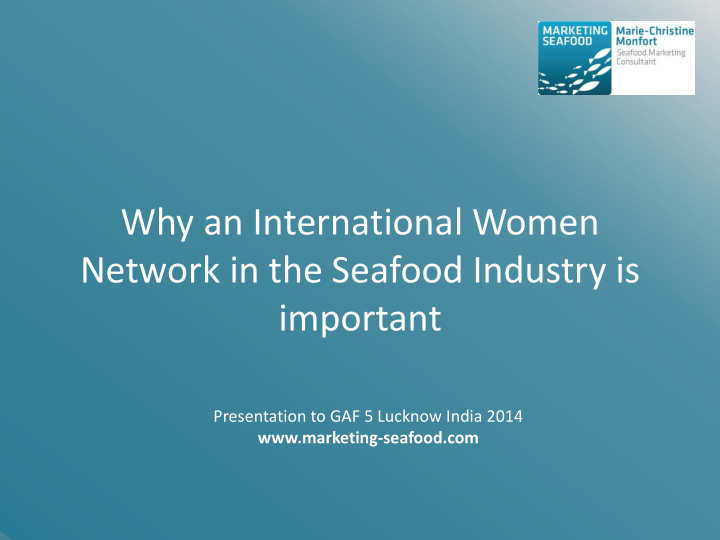



Why an International Women Network in the Seafood Industry is important Presentation to GAF 5 Lucknow India 2014 www.marketing-seafood.com
• Women are here – Fishing, mending / reparing filets, cleaning boats – Managing the husband business – Processing seafood – Selling, trading seafood • Women are invisible – Part time jobs – Subsistance labour not registrered – Not invited to public events – Not nominated in companies ’ boards – Not invited by media to witness • Women are not here – Leadership position
• On the world top 100 biggest seafood companies – Women hold 1% of top executive positions such as president, chairperson and CEO • Out of a sample of 64 companies among the top 100 seafood companies – 55% had 0% women among directors or board members • On a total of 621 senior leaders and board members, 58 are women i.e. 9 % – Compared to 20% in Fortune 100 USA companies
but the difference is that here things can be changed
• FAO – Since 1945, 8 Directors general: 0% – In 2014, 45 directors: 20% – 2014 FAO Fisheries and Aquaculture Department • 3 directors: 0% • Officers, analysts, coordinators: 32% • Clerks, typists, secretary: 89%
• NASF 2012 - 6% • NASF 2015 - 11% (based on programme 05/09/2014) • France Fisheries Forum 2011 - 0% • France Fisheries Forum 2014 - 12% • Global Aquaculture Alliance 2011 Forum - 5% • Global Aquaculture Alliance 2014 Forum - 19%
• Study in the seafood industry on this specific topic ? • Several recent studies in other industries – Catalyst (2007) – Credit Suisse (2012) – McKinsey&Cie (2013) – IMF (2013) • They conclude that there are benefits of having women on-board
• Produce and disseminate facts on inequity and discrimination • Produce undisputed facts on the benefits for better gender equality • Legislative tool: Women Quotas • Help women to propel themselves: re-vitalize Women International Network(s) (WIN)
• 1. Accelerate the advancement of women Objectives • 2. Develop skills including leadership • 3. Create a pipeline towards the industry • 1. Learning: capacity improvement Strategy • 2. Connection between women • 3. Communication, internal and external • 1. Seminars, workshop, summer university, mentoring programmes, scholarship Tools • 2. E-platform • 3. List of female professionals including female speakers
• Because things change only very slowly, we need to demonstrate the benefits for organisations and for women when hiring more women • For that we need: – Power – Organisation – Strategy – Means
• As Meryl Williams, Poh Sze Choo and M.C. Nandeeshaasked during the 4th Global Symposium on Gender in Aquaculture and Fisheries (GAF4) : “The burning questions: If not us, then who?, If us, then how ?” • To this question, my answers are: – Who: Us – When: Now – How: With the support of public, national and international bodies and with creating partnership with private seafood companies
Thank you Engaged women Role models
• McKinsey & Company (2013): Gender diversity in top management: Moving corporate culture, moving boundaries, 20p • Credit Suisse (2012): Gender diversity and corporate performance, 32p • Catalyst (2007): The Bottom Line. Corporate Performance and Women's Representation on Boards • IMF (2013): Women, Work, and the Economy : Macroeconomic Gains from Gender Equity • FAO website • Undercurrents News (2014): World’s 100 Largest Seafood Companies, 293p • Meryl J. Williams, Poh Sze Choo and M.C. Nandeesha (2013) : AFS gender and fisheries networking experiences : what works, what doesn’t? 21p
Recommend
More recommend